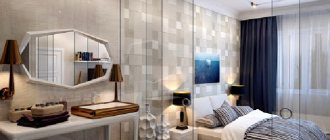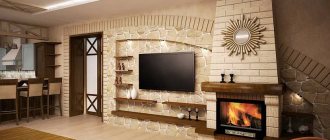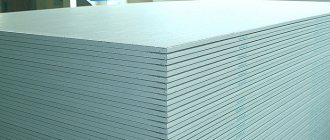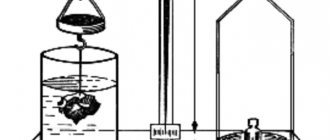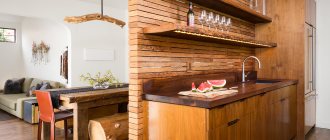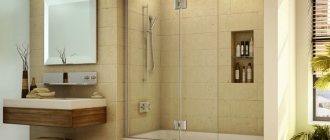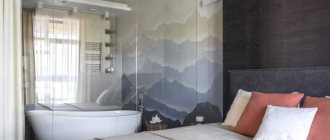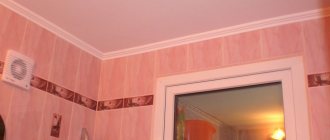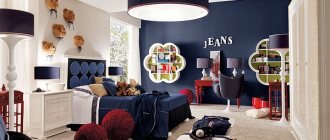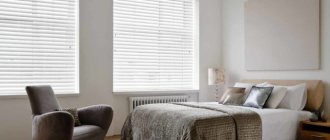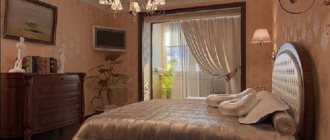Glass partitions in the interior of a modern apartment are a multifunctional element. They serve to solve aesthetic and practical problems, depending on the wishes of the owner and the designer’s ideas. With the help of parts made of impact-resistant glass, you can implement zoning of a studio apartment, visually delimit a large space without weighing it down, allowing light and air to circulate freely throughout the apartment.
Types of interior partitions
A variety of design and constructive solutions allows you to choose any of dozens of possible options, suitable for specific conditions and tasks. The main types of structures made of glass and other materials are divided into the following groups:
- stationary and mobile;
- fully or partially sliding, folding, with swing doors and without doors;
- made of solid glass, glass blocks and frame;
- radius and classic;
- made of frosted, colored, transparent glass, with drawings, stained glass, lighting, and other interior solutions.
Stationary and mobile screens
Stationary glass partitions in the interior of a room are installed fixedly, using special fastenings to the walls, ceiling and floor, with or without a frame base. Their location can only be changed by dismantling them. Such products are often used not only in residential premises, but also in the interior of a bathroom, shower - the so-called “plumbing” partitions, often with frameless glazing.
Mobile types include modules connected by racks, like a screen. They are used as a temporary tool in the design of apartments and offices, helping to zone the space.
Frame and frameless models with and without doors
If, when dividing one large room into two parts, you need to ensure privacy, sound insulation or, as in the case of dividing the kitchen and living room, partially get rid of odors, you will need partitions with doors. Sliding, hinged or accordion-style folding doors can also be used in the bathroom, including to provide waterproofing. Radius models differ from linear and rectangular ones only in the radial arrangement of the guides for sliding doors and the shape of the partition itself. They are more expensive due to their complex shape.
Interior partitions can be made of solid glass or using a frame made of aluminum parts. Usually the frame is made in black, white or wood color, which gives the design an impressive graphic quality. With the French type of glazing with imposts, the frame frame goes not only along the perimeter, but throughout the entire area. This option is perfect for both modern and romantic Provencal interiors, and is also advantageous in that in case of damage, you will have to replace a small element, and not the entire glass. Another popular type of partition is made from glass blocks, which are cast separately and folded into a full-fledged wall like bricks. They provide good sound insulation, transmit light, but are not completely transparent, as in the example in the photo.
Possible options
Interior screens made of tempered glass are also in demand as a means of zoning space. The house is divided into functional zones. This is the most economical way to create additional rooms in a small apartment, while maintaining the light and lightness of the interior. It is worth ordering sliding glass partitions for an apartment or your own home even if there is sufficient space in it. The space will become airy, visually seem larger to you, and will be better illuminated.
Our factory produces sliding structures of various design devices. To get a sufficient understanding of them, we invite site visitors to go to the pages where they are presented
- models with a telescopic opening mechanism;
- semicircular models;
- screens in loft style.
From us you can buy glass partitions for an apartment in Moscow or another city, in the form of interconnected panel elements that fold like an accordion.
Not only sliding solutions are used as fencing - it can even be a large stationary glass structure that partially replaces the wall. Then, as in a number of other cases, a preliminary visit to your apartment by a surveyor will be required for accurate measurements.
Types of glass and design techniques
The material used for the manufacture of interior partitions is duplex or triplex glass, reinforced with a special manufacturing technology, as well as plexiglass, fiberglass and glass blocks. All of them have varying degrees of resistance to external factors, but are characterized by increased strength and are absolutely safe. Any of the above types of glass structures can be used in the interior of an apartment, but when it comes to glazing a balcony or loggia, preference is given to energy-saving double-glazed windows. Plexiglas structures should not be placed near sources of heat and fire: near central heating radiators, fireplaces, ovens, gas stoves.
Various technologies are used to decorate glass elements, including sandblasting designs, engraving, stained glass details, and colored inserts. Even simple clear, frosted or textured glass in the same room will look different, creating special visual effects. Another fashion trend - glass with colored or neutral lighting - is ideal for a modern apartment in the style of pop art, hi-tech, modern, minimalism.
Accommodation options
The resting place is located in the corner of the room and is fenced off with a screen or curtain. A partition divides the room into two equal zones: a sleeping area and a guest area.
You can place a dressing table next to the bed, and in the guest area you can place a small sofa or soft chairs, or a coffee table.
For watching videos and TV programs, a plasma TV on the wall is best. The most important thing is not to fill the space with objects.
A large room can be divided into two zones using a large shelving unit with a blank central part installed in the middle of the room. Place a guest or work area on one side, place a bed on the other, with the headboard in the center of the rack.
The bed and workspace adjacent to the same wall can be separated by a glass panel, a small shelf or a stationary partial wall. Such a partition can be made in the form of a fake fireplace, shelves built into a solid wall, etc.
Why are partitions needed in an apartment?
Glass partitions in apartment design are used:
- for room zoning;
- to ensure complete or partial privacy;
- as a redevelopment option;
- for decorative purposes.
A glass partition is a fairly fashionable and effective zoning tool. The visual division of small studio apartments and large loft-style spaces into a cooking and eating area, a relaxation area and receiving guests allows you to emphasize the purpose of one or another corner of the apartment without cluttering it, leaving accessible visibility and without interfering with the penetration of artificial and natural light.
If you want to allocate a corner for work and leisure in your apartment, you can design it as a mini-office using a glass partition with a sliding or hinged door. Frame structures and frosted or colored glass guarantee some privacy, but it is impossible to completely ensure sound insulation in this way. The same can be said about partitions that partially isolate the bedroom from the living room or the children's room from the adult bedroom.
In cases where redevelopment of an apartment and the construction of standard partitions are impossible due to the design of the house or official prohibitions, glass dividers can solve the problem of delimiting space. Most often, this technique is used to delimit the kitchen and living room areas with a stationary structure with sliding transparent doors. In interior design, glass partitions are also used for purely decorative purposes. Such structures, usually made of solid glass, are installed in living rooms and dining rooms, bedrooms and hallways, supplemented with original elements: stained glass paintings, sandblasted patterns, engraving, making them colored, backlit, with matte or mirror inserts.
Current trends in the design of glass partitions
The fashion for interiors with glass partitions has been steady for a couple of decades, changing only the guidelines. In 2021, designers focused their attention on several styles, suggested experimenting with light-color effects and even getting a little rowdy. Let us note the most interesting trends.
Art Deco
This style is characterized by large ornaments on the walls, intricate shapes of furniture, discreet shine of brass against the background of matte and velvety materials, pastel colors (French vanilla (yellow-cream), pink and mint shades are now popular). Glass partitions in an art deco interior are preferably transparent - such material contrasts effectively with the brass frame and fittings.
Photo 1 - Glass partitions in an art deco office interior
Instead of glass sheets, you can use mirrors. This technique will visually expand the room, and the reflected rays of the lamps will make the space brighter.
Photo 2 - Mirror partition with brass-colored layout
Photo 3 - Art Deco screen
Urban glamor
This type of loft style involves the creation of a brutal space, enriched with elegant items and a mix of materials. Glass partitions in the interior of an apartment, decorated in the trends of urban glamor, are distinguished by a geometric layout in the form of squares. Most often, the frame is painted in a neutral black color, which easily “reconciles” surfaces of different textures and palettes. In glamorous lofts, glass, brick, wood, expensive textiles, stone, and leather organically coexist.
Photo 4 - Interior in the spirit of urban glamor
As a rule, sliding partitions are used in urban design spaces: glass panels are fixed to the guide rail with large fasteners. The moving components of the structure are not hidden; on the contrary, they are clearly visible, which corresponds to the canons of the industrial direction.
Photo 5 - L-shaped glass partition in the interior of the apartment
Glass interior partitions with plot sketches of city streets also fit perfectly into glamorous urban spaces. Sandblasting technology and decorative film are the most popular for applying images.
Photo 6 - Installing glass partitions helps stylize the space
Lettrism
Interior designers use the basics of this avant-garde movement when creating letter compositions (lettre). Most often they make up combinations without any lexical meaning, just beautiful pictures from different fonts.
Photo 7 - Sliding glass door, lettrism style
However, it is not forbidden to use the potential of lettrism for self-expression, stimulation of thought processes and any activity. For example, when installing glass partitions in an office, you can order canvases with corporate slogans, aphorisms, song lyrics, encouraging phrases, etc.
Photo 8 - Call to dream and do (inscription in English)
Ecostyle
The basis of eco-style is naturalness. This means that glass fits into this concept perfectly, especially since it combines perfectly with other natural materials. In addition, all-glass partitions can become an ideal basis for decoration: stylized and naturalistic images of plants and landscape paintings look impressive on a large transparent surface.
Photo 9 - Beautiful glass partitions in the interior of an eco-style bathroom
Glass allows you to realize extraordinary ideas. For example, from panels of material you can create not just a partition, but a real room with four walls, a ceiling and a door.
Photo 10 - Cube room inside the hall
Advantages and disadvantages
Glass partitions used in apartment interiors have their disadvantages and advantages. The advantages include the following characteristics:
- the transparency and visual weightlessness of the structures do not clutter the room, allowing air and light to penetrate into the farthest corners;
- safety even for families with small children (triplex or duplex glass is very difficult to break, but if this happens, it will crumble into large fragments with rounded edges that cannot be injured);
- multifunctionality;
- environmental friendliness;
- the ability to achieve partial sound insulation and privacy;
- endless scope for realizing any design fantasies, compatibility with different interior styles.
Disadvantages of glass partitions:
- quite high cost (the more complex and original the design, the more reliable the glass itself, the more expensive);
- complex installation work that requires leveling the floor, walls, ceiling, and high professionalism;
- incomplete sealing (odors will penetrate from the kitchen into the living room, and high humidity from the bathroom into the bedroom);
- It is impossible to conduct communications through such a partition; it is impossible to hang a picture, a clock, or a TV on it.
Decoration
When decorating a room with partitions, you can choose any interior style. Panels or screens are decorated using paintings ranging from geometric shapes or flowers (all sorts of stencils are often used to apply them), and even depicting all kinds of still lifes, various kinds of sea or forest landscapes.
One of the simplest ways to decorate is to stick vinyl-based applications or photo wallpapers.
To decorate the partition between the living room and bedroom, a panel assembled from puzzles, mosaics, postcards, copies of any paintings, or embroidery placed in a frame can also be used. In this case, as in everything, it is necessary to observe a sense of proportion - you should not turn the bedroom into an art gallery.
Walls made in the same style as the figured ceiling, or with wavy or oblique edges, look very interesting.
Don't forget about the lighting. Modern technologies make it possible to use both halogen lamps and fluorescent and LED light sources.
The latter are supported by a fairly large range of colors and economical consumption. In addition, in the bedroom, lighting can play the role of a night light, and this is a definite plus.
Partitions with protrusions are sometimes decorated with finishing stone, sea or river sand, pebbles or shells. Inserts made of colored glass or glass blocks look very original; mosaic panels and stained glass windows give the structures a magnificent look.
Low partitions and racks are used for decoration with fresh flowers. Climbing plants look especially impressive.
By the way, using them, you can get a living partition, but be patient - plants are not drywall, and you won’t be able to create a green curtain quickly. But this inconvenience is temporary, and the result can exceed all expectations.
In any case, before deciding to install a partition, it is necessary to develop a design project for the entire room, calculate the required amount of material, and only then implement the decision. Thinking through the details allows you to create a cozy and comfortable space for complete relaxation.
Where to place it?
Glass partitions are most often placed at the border between different zones in the same room. Thus, partitions in the form of a glass cube are installed to separate the master bedroom from the living room; the same technique is applicable to separating a nursery in a common room with parents. In some modern studios, the bath is located in close proximity to the bed, or even right in the bedroom area. Instead of a regular glass partition, it is better to install a solid, sealed structure with sliding doors, which will protect the owners from excessive humidity.
The traditional option is a frame glass partition between the cooking and eating areas, between the dining room and living room, kitchen and living room. In the entrance area, partitions allow you to separate the dressing room from the corridor or room, and visually distinguish between the hallway and the apartment. Transparent and opaque glass designs are perfect for creating a mini-office, decoratively dividing a room into a bedroom and a living room.
Types of glass partitions
The following types of glass structures for the bedroom are available to users:
| Stationary | Massive, installed from floor to ceiling on a rigid frame. They serve as a replacement for a full wall, but there are also low options that separate one area of the room from another. |
| Sliding | Sliding partitions are, in a sense, an alternative to doors. To enclose a space, it is enough to close the canvas; to combine it, open it. |
| Mobile | Designs that can be moved around the room. They are not attached to walls, floors or ceilings. They can be of any size, there are folding options, and are often equipped with wheels for ease of movement. |
| Radial | The glass has a shape curved to a certain degree. Systems can be sliding or hinged. |
| Folding | Large canvases that fold like a book or an accordion and slide to free up space. |
